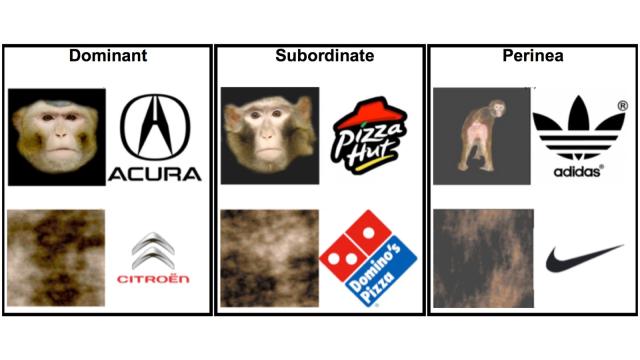Humans assign value to brands. Brands represent wealth, strength and yes, sex. We are our brands. And for some rhesus macaques in a lab, one brand, Adidas, represents monkey genitalia.
The brand associations (Image: Acikalin et al, PLoS One (2018))
You may have seen the wacky image above circulating online. It’s from a fairly incremental set of scientific results that don’t say much about us as humans. But you might want to know why a team of scientists have somewhat bafflingly combined the words “Dominant”, “Subordinate” and “Perinea” with six well-known brands and photos of monkey faces and rears.
Basically, the researchers were studying whether monkeys can associate brands with sex and power.
“We know how social rewards can be processed differently compared to primary rewards like food or water,” the study’s first author M. Yavuz Acikalin in the Stanford Graduate School of Business told Gizmodo. “Essentially, what this is looking at, ‘is can monkeys also associate the rewards with arbitrary stimuli, and create associations more directly though conditioning.’”
Acikalin admits that this study is incremental and small, with only ten monkeys (five male, five female) included. The researchers paired dominant male faces, subordinate male faces, and female hindquarters with some brand logos, then paired scrambled images with other brand logos.
The scientists trained their simian subjects to use a touch screen before the experiment. During the trials, each monkey saw the logos paired with their corresponding images. Later, they had to pick between two brand logos — one that was associated with a face or a butt, and another that was associated with the scrambled image, according to the study published recently in PLoS One.

The experimental setup (Image: Acikalin et al, PLoS One (2018))
Some of the highlights: The monkeys were statistically more likely to chose the logo associated with the non-scrambled image, and the monkeys were more likely to pick the hindquarters image than the subordinate images. They were also more likely to pick the brand affiliated with the hindquarters or the dominant monkey than the subordinate monkey.
Obviously, this is an association study with only a few monkeys that has its limitations. Acikalin told me that you can’t really generalise the results to our human brains — it just provides further evidence that the macaques can associate brands with attractive images. He mentioned that it’s a study mainly meant to replicate other, older results that demonstrate monkey preferences.
Additionally, he said that the brand choice was arbitrary — though “I may have unconscious biases linking sports brands with more sexual advertisements.”
You know what they say, sex sells. Also, Adidas is the preferred brand of at least a few genitalia-loving macaques.
[PLoS One via Max Read’s Twitter]
